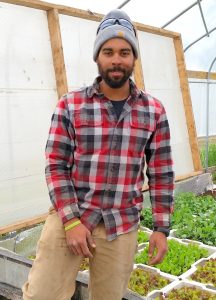T.D. Holub shares his thoughts on three tricky vegetable crops
T.D. Holub and his wife, Sarah, raise vegetables, eggs and pastured broiler chickens on 10 acres at Garden Oasis Farm, near Coggon, Iowa. T.D. will co-lead a session on cauliflower production at Practical Farmers of Iowa’s 2019 annual conference, “Cultivating Connections,” Jan. 17-19, in Ames.
The cauliflower session is one of three offered at the conference focused on crops that present some unique challenges to Iowa’s vegetable growers, including cauliflower, eggplant and storage onions. In this guest post, T.D. shares details about his experience with these crops.
 Eggplant: In general for my farm, storage onions and cauliflower tend to be a little bit trickier than eggplant. While eggplant still has its struggle points, in most cases it does well for me. With that being said, in 2018 I experimented with planting some eggplant in a high tunnel as well as out in the field. My result was a very nice, high-quality product in the high tunnel plants with little to no blemishes. However, the overall yield was not as good as the outdoor ones. Many factors influenced this, but mostly it was because I didn’t take the time to trellis the eggplant more than once, which led to the plants sprawling out on the ground.
Eggplant: In general for my farm, storage onions and cauliflower tend to be a little bit trickier than eggplant. While eggplant still has its struggle points, in most cases it does well for me. With that being said, in 2018 I experimented with planting some eggplant in a high tunnel as well as out in the field. My result was a very nice, high-quality product in the high tunnel plants with little to no blemishes. However, the overall yield was not as good as the outdoor ones. Many factors influenced this, but mostly it was because I didn’t take the time to trellis the eggplant more than once, which led to the plants sprawling out on the ground.
Next season, I will be more diligent in trellising, and my hopes are to produce half my eggplant for co-op sales from my high tunnel. The outdoor crops of eggplant always have high yields, but many times there are blemishes, bug holes and scabbing. This gets worse as the summer progresses, but we do little management other than mulching around them and occasionally treating for flea beetles or Japanese beetles as necessary. I believe most of my struggles are related to the plants getting too heavy and falling on the ground. This leads to the fruits resting on the ground and especially in wet years this has caused trouble.
Cauliflower: For cauliflower, I think the biggest issue is weather and pest pressure. Many times, multiple bugs can get into cauliflower when the heads are getting large enough for sale. This is easy for them to do because cauliflower has tons of places for bugs to hide. I find that, in the spring, my most effective strategy is to plant a fast-maturing variety that has some heat tolerance. For me, this one is usually Snow Crown. We aim to harvest our first round of cauliflower in mid-June, but [in 2018], that was delayed to July.
Normally, when I get it out in the June time frame, we have little pest pressure. A couple of years ago I tried to grow cauliflower all summer, but found it to be difficult. The main issue I was facing was the wrapping leaves would open and expose the head to excess heat. Coupled with above-average moisture and humidity that season, many heads would go bad in the field. I just find that with our climate, cauliflower all summer doesn’t work for me.
Even though I chose varieties with a high heat tolerance, it didn’t seem to matter. For that reason, I have mainly just focused on spring plantings, and then a larger fall planting of white, purple and romanesco cauliflowers. If planted at the right time, fall cauliflower can be some of the best things we grow on the farm. The bug pressure goes down, and most of all, the heat is less, which allows you to let the heads mature for a longer period of time.
Storage Onions: I don’t really have much on onions. I have struggled every year with them, whether it be a variety that didn’t do well or the whole crop, like [the 2018] season. Until [the 2018] season, I would always let onions dry in a open shed on hay racks. This was effective but not ideal for many reasons. [During the 2018] season, we cured a good portion of our onions in a high tunnel with good results.
My plan for 2019 is to start all of my onions, leeks and shallots from seed and set out as transplants rather than purchasing from Dixondale, as I have in the past. My hope is that by planting a more robust, fresh transplant, I will get them off to a better start in the field, thus allowing me to tine-weed more effectively. My hope is that by controlling the weeds and opening up airflow better than I have in the past, the onions will mature more efficiently. Once ready, I will cure them in the tunnel and see if that leads to a longer storage life.
Learn more about these three crops — and other vegetable production issues — at the conference!
